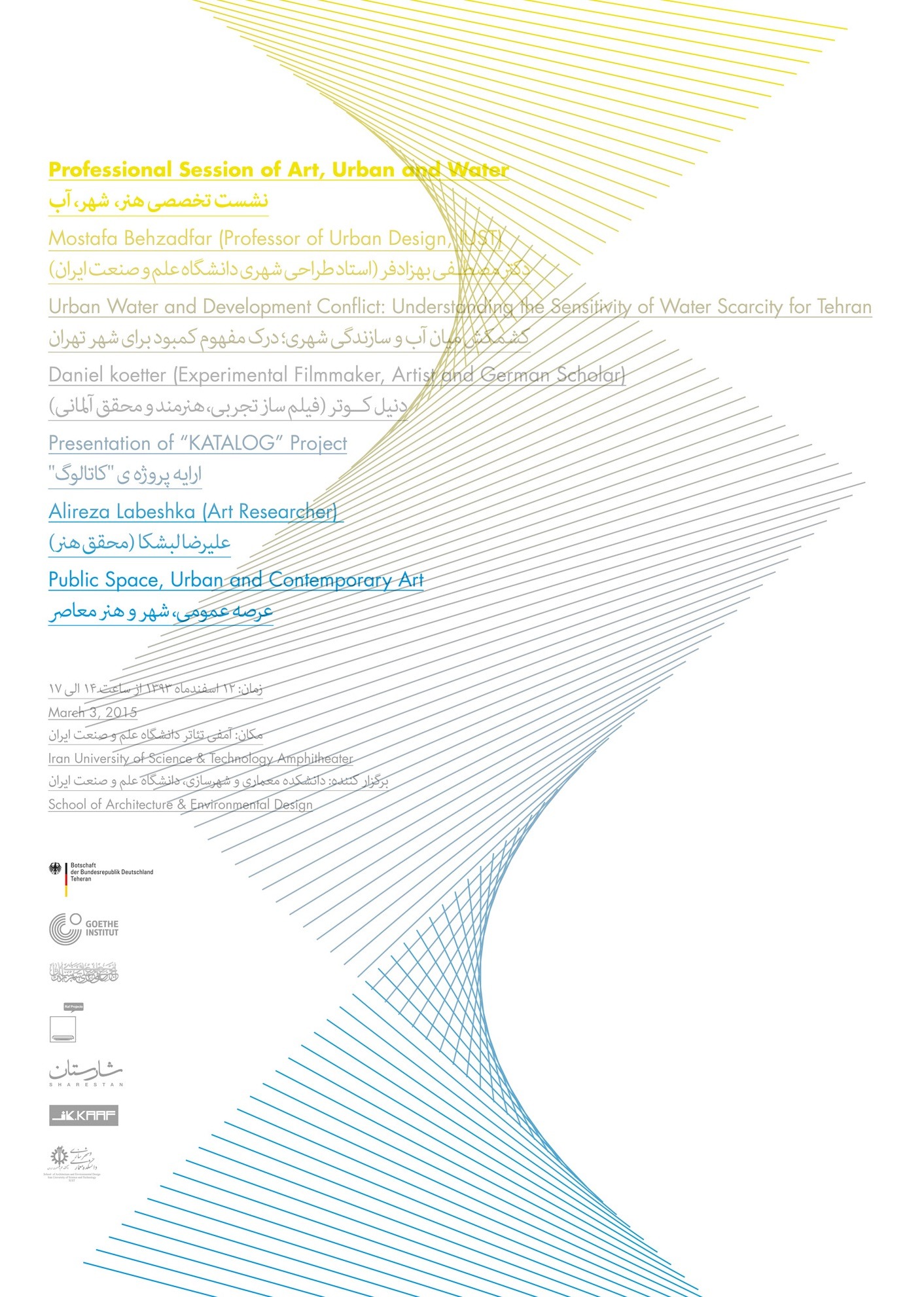Talks on City, Art and Water
Series of Lectures and Presentations
March 3, 2015
Iran university of science and technology

Talks on City, Art and Water Series of Lectures and Presentations 1. Mostafa Behzadfar (Professor of Urban Design, IUST) Water and Urban Development Conflict: Understanding the Sensitivity of Water Scarcity for Tehran 2. Daniel kötter (German Video Artist & Experimental Filmmaker) Presentation of “KATALOG” Project 3. Alireza Labeshka (Curator & Art Researcher) Public domain, City and Contemporary Art March 3, 2015 2 to 5 pm Iran University of Science & Technology Amphitheater School of Architecture & Environmental Design “Tehran, like many other developing cities in the global South, is facing widespread urban transformations. But maybe since six years ago its urban transformation cannot only be examined in relation to urban development dialectic borne in mind by technocrats and the capitalist policies of those serving the circulation of capital; rather these changes can be reviewed in the shadow of agoraphobic policies and from the viewpoint of controlling social activities of citizens and limiting the scope of their possible physical movements. During the past five years, iron bars were erected around main city squares using the traffic management as an excuse. Later on, even the presence of people on the corners of these squares was intolerable to them and the municipality, by executing projects such as City Theatre Junction and in the near future the Vali’asr Square project, transferred the human traffic in populated areas to the underground under the surveillance of CCTVs. Streets in Tehran are widening every day and sidewalks are becoming narrower. Despite the civil objections of citizens, highways destroy the urban texture, Plazas and communication centers of Tehran residents not covered by the media so as to facilitate the everyday urban commute of people in their sedans like space passengers and there is no real sign of motivating people to travel the daily distances by public transportation, going on foot, bicycling or any other transportation or intercity trips in which the communication of citizens with each other is imaginable. The Municipality has spent half of the total expense assigned for the development of Tehran Subway lines during 18 years for turning the 11 Km Sadr Highway into two stories. The deployment of grade separations (interchanges) built as a means to facilitate the traffic in crossings are among other civil projects which can be interpreted alongside the similar projects as fulfilling the objective of decentralization. It seems that all these transformations in the urban structure and public domain and relations thereof to the issue of social liberalism are unnoticed by supervisors and critics inside the country or overseas and they have only focused their efforts on caring about principal manifestations of human rights status such as freedom of the press the right to vote in Iran, neglecting “space” and “production of space” and the role and potential thereof in having a free society. “Tehran Urban Hegemony” Project is initiated in a bid to reflect the critical reactions of contemporary artists of Iran to the transformations of public domain.”i Among the artists who is contributing to this project the curator, Alireza Labeshka has invited Daniel Kötter who has the experience of being in Tehran for four times and who made an experimental movie titled “state-THEATRE #Tehran” which won the prize of best experimental movie in EMAF festival 2012. Kötter’s travel to Iran make him a remote but near observer of rapid urban transformation in Tehran who can provide the local audiences with a creative new perspective to this city. As a sequel to the planned events around the presence of Daniel Kötter, German experimental filmmaker, Artist and researcher, in Iran he would give a lecture on 3rd March 2015 in Iran’s University of science and technology’s main Amphitheatre. Mr Kötter, in this one hour event is going to show excerpts of his video and text project KATALOG, which was shot around the Mediterranean sea and deals with questions of architectural and social development in cities in the Mediterranean area. Daniel Kötter , through the artistic strategies of visual research, contextualization and video art ,has tried to explore how the built form represents a physical and imaginary landscape for the societies around the Mediterranean Sea. Afterward, Mr. Alireza Labeshka would introduce certain theoretical approaches to the urban space, including the “relational space” theory of David Harvey. Then he is going to analyze some characteristic contemporary Artworks related to the question of the city. He would introduce “Big Vortex ” and “Flussbad” among the projects of the “realities-united” art and architecture group. Additionally he would discuss some projects by “Francis Alyss ” and “Alfredo Jaar” and Also Mohsen Yazdipour and Neda Razavipour among Iranian Artists. In this program Iran’s University of science and technology has invited editors of the journals such as Sharestan, Memar, Namaye-ye- Tehran, all of which address architectural and urbanistic issues. Activists of the “Bahamestan” group, members of the association of architects and urbanists, house of architecture and architecture and urbanistics faculty of Tehran University, Shahid Beheshti university, Tehran Islamic Azad university are also invited in order for them to get up to date on the latest Artistic approaches to the urban issues and the activities of this outstanding German Artist. Presence of Mr.Kötter in Iran has become possible as a result of the collaboration among following entities: German embassy in Tehran, Goethe Institute, Kaaf, Sharestan journal of Architecture and Raf projects. i From project proposal for “Tehran Urban Hegemony” by Alireza Labeshka.


